Click here to read the November 2020 issue of The Flimsy Board from the Bremerton Northern Model Railroad club.
You are browsing archives for
Category: Articles
How to’s, presentations, and informational articles
Mt Vernon Fall 2020 Non-Clinic Report
Click here to read the Mt. Vernon Non-Clinic Report for Fall 2020.
David Yadock’s Dry Gulch & Western Railroad – Part 8
Article & Photos By David Yadock
Dry Gulch & Western, A Photo Series Part 8
I’m sure there are some of you that are interested in operations and how it plays out on my layout. At first, I was only interested in “running trains” and layout photography. After an invitation to participate in the Oly-Ops operating sessions from Ed Liesse my view on operations changed. I admit my layout wasn’t specifically designed for operational running of trains, but I have made some significant changes to lend itself to be more operations friendly. The two main yards were migrated closer to the aisles and additional sidings were added to the track plan.
Yes, being an operator on my layout requires some skill but running a freight or yard can be an enjoyable experience even for the novice. The easy jobs are passenger trains and fast freights. These allow a first-time operator to learn the basic operation of the layout and to determine exactly where cities/yards are on the layout. They also learn the location of critical passing sidings. Another element on my layout is tonnage. Yes, trains can stall on some of my main line trackage. Operators really need to follow their train and be aware of the tight curves on steep grades. This can cause a standard freight to come to a dead stop and just sit and spin its drivers. Some trains may need to double a mountain grade while other freights need a pusher locomotive to help with the grade. This is all part of the fun!
For the basics, I use car cards and the “mother may I” approach for dispatching/yard control. There is no distinct schedule for trains to run but that may change in the future. There are a variety of jobs, some can be easy, some can be challenging, but all are a lot of fun. The jobs range from passenger trains, mixed freights, peddler freights, fast freights, transfer runs between yards, branch line local runs, and a couple yard jobs. There are enough jobs for 6-7 operators. Operating sessions run about 1-1.5 hours. Now onto more of the layout tour.
Photo 36 shows the view looking down my large canyon. To the extreme left is my curved wooden trestle that carries the mainline out of Dry Gulch. On the upper right is the arch bridge spanning the valley where the town of Hayes River is located. The scenery in the foreground is still incomplete but most of the scenery further into the canyon is finished. For you John Allen fans this photo may remind you of his layout. Again, I tried not to copy his layout but to produce similar scenes. Please excuse the car cards sitting on top of the freight cars!
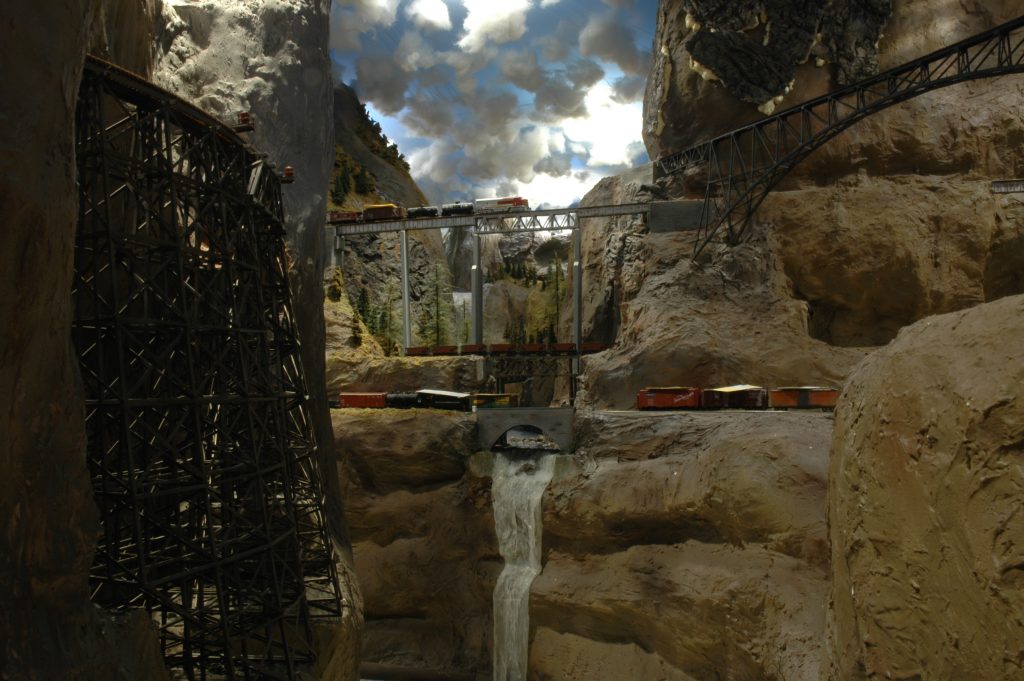
Photo 37 gives a low angle view looking at the town of Hayes River. A smaller yet to be named town resides higher up in the photo. During the Covid-19 stay at home situation I have done some plaster surgery in this area, so it has changed a bit from when these photos were taken. The track that has the ore cars on it is the narrow-gauge line leading to Electric City. The bridge in the lower right carries the mainline spiral around the mountain. You may note the white block with number 25 on it in front of the “Selecto” reefer, those marker buoys help identify the turnout on the control panel. These were a great suggestion made by Russ Segner. I did make them removeable for photos but since these photos were taken right after an operating session I chose to leave them in place.
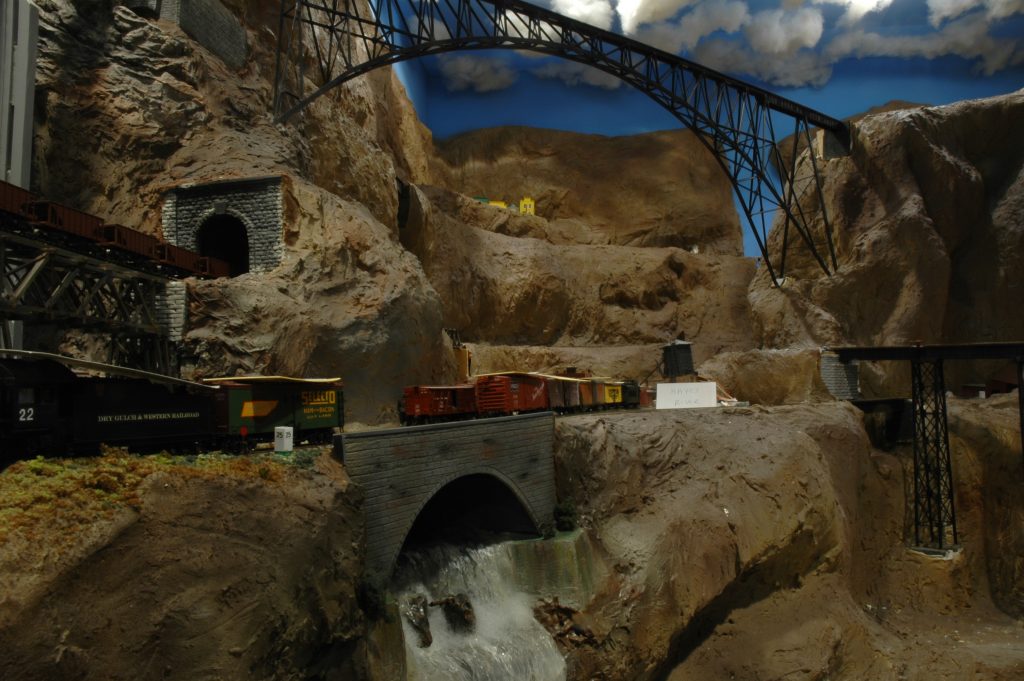
Photo 38 is a high view of the arch bridge. The town of Hayes River is below with its access hole. The “no name” town is in the corner of the room. Hmm, I have lots of scenery to complete!
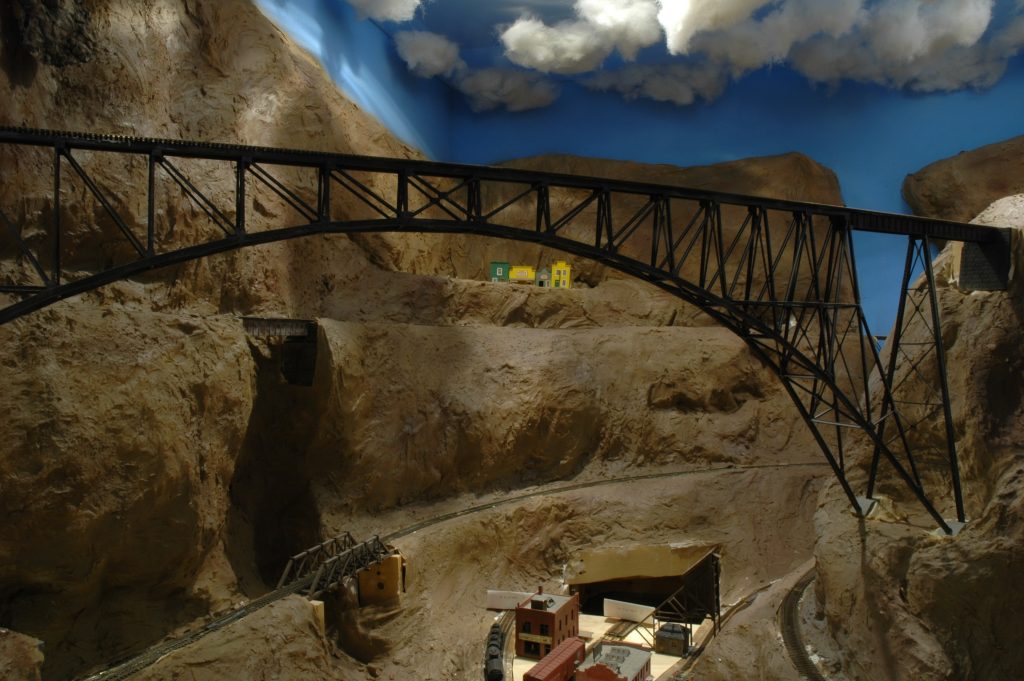
Photo 39 is a view of all the bridges that traverse the Hayes River. Way in the back is a wooden thru-span, up front is the silver colored high bridge, beneath it is the wooden deck truss that the narrow-gauge line uses, and finally up front is a stone arch bridge. The tunnel to the left in the photo leads to Electric City far in the valley by the tall waterfall in the background.
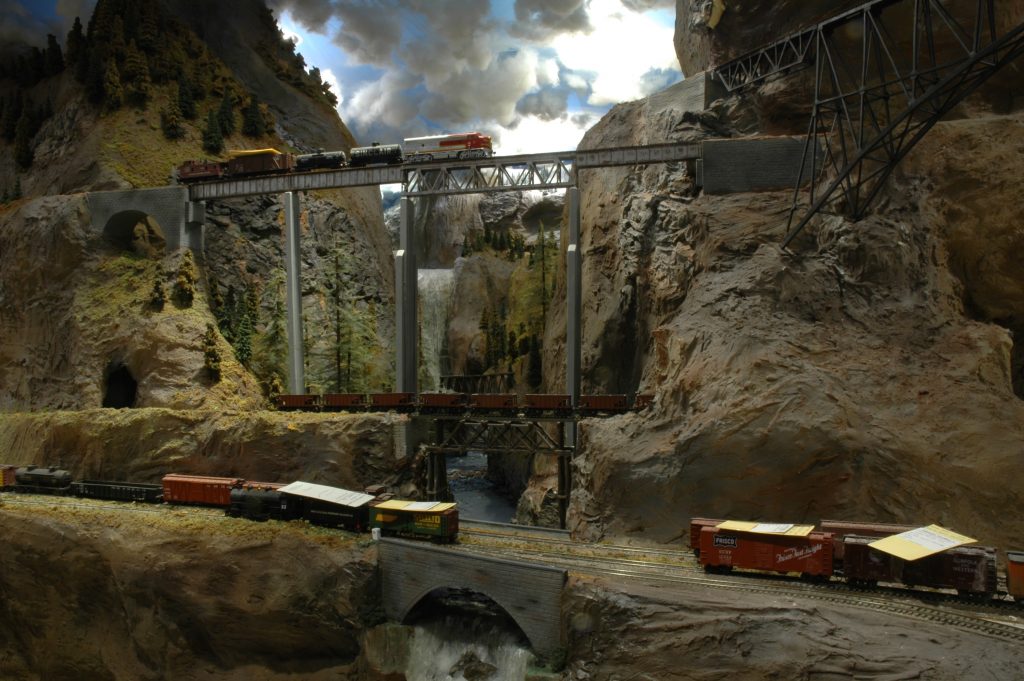
Photo 40 is a helicopter view of the valley taken just in front of the high bridge. This photo gives a better view of the wooden thru-span bridge from photo 39. On the right you can see the gray painted water tower and part of the town called Tallyn Pass. Most of it his hidden in this photo. It has a nice witch’s hat roof station. The station was built from plans of the South Lyon station that is still located in Michigan. You can also see the snow-covered mountains in the background. Can you spot where the mirror is located? How about the location of the access hatch? If any of you have seen my clinic called “Art of Deception” then you will know where they are located. Directly behind the mountain to the left is the small town called Electric City. It has a small station and an electricity generating facility at the base of the waterfall. The mountains along the wall in this area have multi-color LED strip lights behind them. Those lights can be turned on to produce a realistic sunset lighting effect.
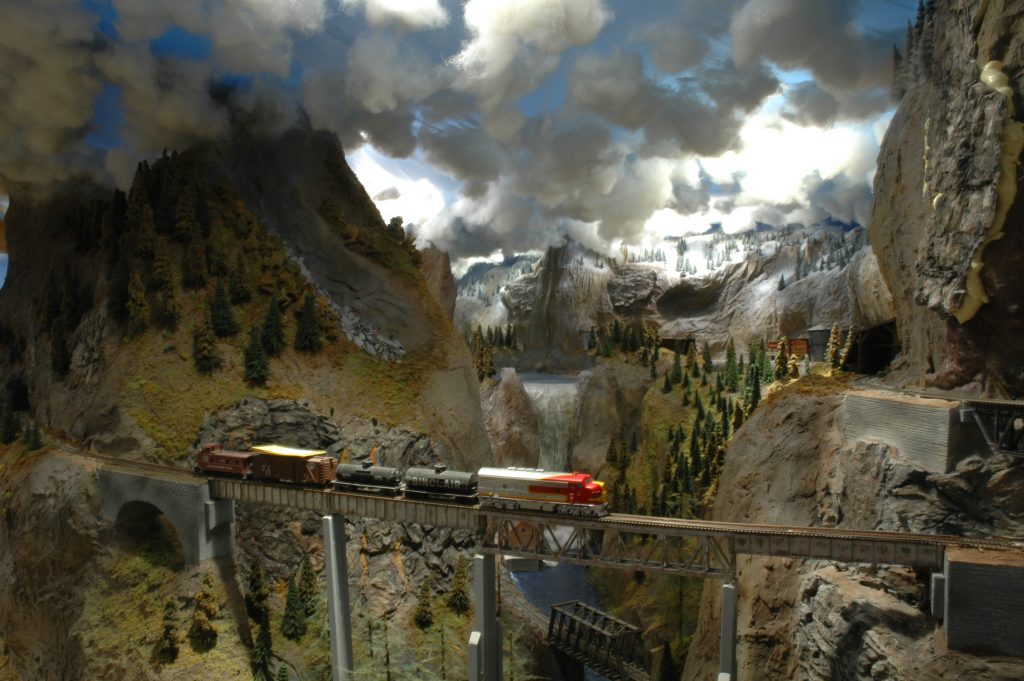
Next time we will move further down the mainline. Could there be even more bridges?
David
Chuck Ricketts Fantasy Island Railroad – Parts 6, 7 & 8
Click here to read the eighth article on Chuck Ricketts Fantasy Island Railroad.
Editor’s Note: Parts 6 & 7 from the series were lost in transit and had not been posted. That has been straightened out and the links are included here in case you missed them.
Click here to read part six.
Click here to read part seven.
Bremerton Northern October 2020 Flimsy
Click here to read the October 2020 issue of The Flimsy Board from the Bremerton Northern Model Railroad club.
The Confessions of a Hi-Railer
By Ed Ives
I’ve always had an interest in trains, cherished my trains as a child and at the age of 30-something time came to graduate to ‘Model Trains’, or so I thought. My interests lay with UK trains, the ones I grew up with and not those here. Sorry about that.
The options were to either scratch build with the use of machine tools like a lathe etc. which I do not have or kit build in O gauge or OO gauge. O gauge kits and bits were few and far between whereas OO parts were readily available and affordable, so OO kit build as a starter it was.
OO gauge is a bit of a compromise, 4 mm/ft for the structure running on HO track which is 3.5 mm/ft, so OO gauge trains are kind of narrow gauge. Perfection is needed, so I thought, true 4 mm/ft, hand built track and of course re-gauged stock. At that time in the UK there were three standards for true scale models; P4 and S4 competing standards using a track gauge of 18.83 mm and an older standard of EM gauge of 18 mm/ft. Hum, what to choose? Well 50 years ago both the P4 and S4 societies were in their formative years and maketed their own parts none of which matched what I wanted to build, LMS stock. I settled on EM gauge for the time being.
I chose to start with building some simple kits, passenger cars and choose the track standard later. I started with something really simple, or so I thought (are you getting the drift here?), a Graham Farrish kit of a LMS commuter passenger car, three of them. The kits could not have been simpler, a plastic molded body, four sides and a base as one piece, a metal channel as an frame to take the trucks and the framework between and lastly a metal curved roof, a shake the box and they are all assembled. I purchased separately sprung buffers to replace the molded ones, ventilators for the roof and lastly a book of drawings of LMS passenger cars.
A start was made on assembling the kits and using the reference drawing from the book as a guide.
- Oops, the trucks lack the foot boards that came in two different versions. No problem I can make foot boards out of thin plywood and attach to the trucks with epoxy cement. Job done.
- Oh dear the truss rod under frame was too short and made as a one piece white metal casting. Hum, do I throw them away and make new out of brass? I decided to save that for later.
- Oh, again the drawing shows all the other stuff that hangs below the floor; dynamo, battery pack, vacuum cylinders and so forth not included in the kit. I go off and make these parts as best I can.
- Door handles; grab handles and handrails were not included in the shell molding. I make these out of piano wire. The door handles were a real pain as there are so many of them about sixteen per car.
- Ah, the roof does not fit correctly with gaps at the ends of each car and resists being reformed. I get this bright idea to mold the replacement roofs out of styrene sheet. A plaster mold was made and the first production drape formed roof made. Disaster! The styrene sheet shrinks when gently heated in the oven as well as curls up something like an oversize fortune cookie. My wife is concerned that I’ll ruin the kitchen oven and calls a stop to this effort. Go back to basics and fashion roofs from thin sheet metal which become quite effective. It shows that I developed skills repairing the bodywork on my first car while at college. Rain strips made out of piano wire again, is used and soldered to the roof. Holes drilled and the ventilators added. Now we’re getting somewhere I feel.
- Oh, I wish for high frequency passenger car lighting. I build a high frequency power generator out of an old TV set and experiment with Plexiglas strips, grain of wheat bulbs and diodes to find a workable solution that fit nicely within the car. Someone suggested that I needed a license for the generator, license, what license, hum?
- The molded buffers are cut off the car bodies and the replacement sprung buffers are added. I re-gauge the wheels for EM and mount in the trucks as a test. All complete less painting and interior, I put the assembled cars on a piece of track and they look great. The nagging issue is they each weigh a ton, feel like they are made out of solid material, way too heavy for the appropriate locomotive to pull. And it only took me THREE years to do and I still have that bum under frame to deal with.
Conclusion – Life is too short to build me a scale Model Railway.
Ed Ives
The Confessions of a Hi-Railer
David Yadock’s Dry Gulch & Western Railroad – Part 7
Article & Photos By David Yadock
Dry Gulch & Western, A Photo Series Part 7
I’m sure many of you have been wondering about my freight car fleet. In the early years I had just about every siding and all the yards full of cars, but I learned! Now I keep around 100 or so cars on the layout. Since I have become involved with operations I try keep the yards about 1/3 full of cars. This helps or sometimes hinders car sorting for yard operators. I do have around 250-300 cars in total with most being stored on specially constructed shelves. All my cars have had metal Walthers Proto wheelsets installed on them along with standard Kadee #5 couplers. I did test Kadee “scale” couplers on some of my cars but found they did not couple well with the standard #5 couplers in certain situations, they have since been removed from those cars. My fleet of cars come from many various manufacturers and most are older non-superdetailed cars. I still can’t believe that some of my early cars that I have on the layout were purchased for 50 cents each! On my layout you can find a mix of AHM, Roco, Atlas, Athearn, MDC, Tichy, Varney, Ertl, Life-Like Proto, Ulrich, Tangent, and Accurail models all working on the layout. I still have the three original AHM freight cars from my very first train set, yes are on the layout! Regarding freight cars, I have found the key is to have them all run and perform well. If they do not, then they get pulled from the layout, tagged to identify the problem, and replaced with another car. There are plenty of replacement cars waiting in the wings to go onto the layout. Also, if you have been noticing, there are a lot of east coast railroads represented in my freight car fleet. Originally, I was thinking of creating a layout that would be based on the prototype Pennsylvania RR. That didn’t happen. I still kept the cars for the Dry Gulch & Western and used whatever road name that I liked. I admit, if the car has eye-catching graphics that is a plus. Another issue, the cars do not fit any specific era. Yes, I have billboard reefers that ride on arch bar trucks. I even have some ancient wooden passenger cars. I do try to have freight cars that are generally from the steam era. One thing I still do not have are some home road freight cars. I have a few but there are still a lot of freight cars in boxes that need to be built and lettered specifically for my railroad. Like with all model railroads there is always something that needs to be done.
Photo 31 shows a closer view of the tunnels and the right abutment of my version of the Canyon Diablo Bridge. This view shows how I attach some rock plaster castings. I use expanding spray foam. The surrounding areas behind the casing will be filled with joint compound. The joint compound will be carved and then painted. Ground cover will be added later.
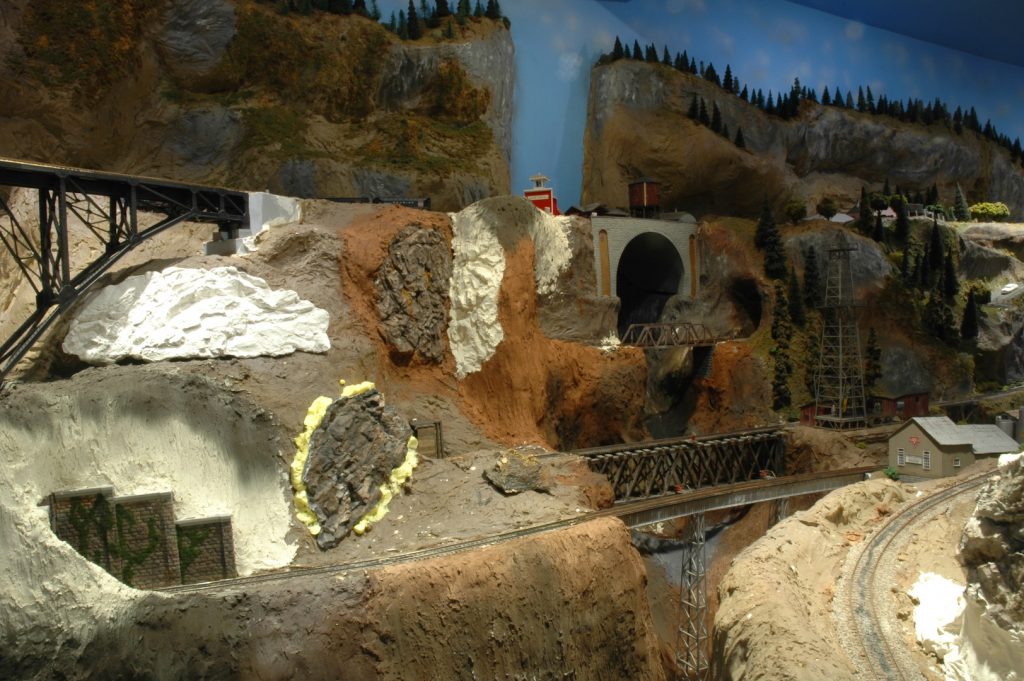
Photo 32 shows a full view of the bridge. In the bottom corner of the photo you will see a silver SP gondola, one of my original “trainset” cars! Note how the mirror in the corner allows the room to expand. The mountain to the left is completely hollow along the backside. That gives me plenty of access to the track in that area.
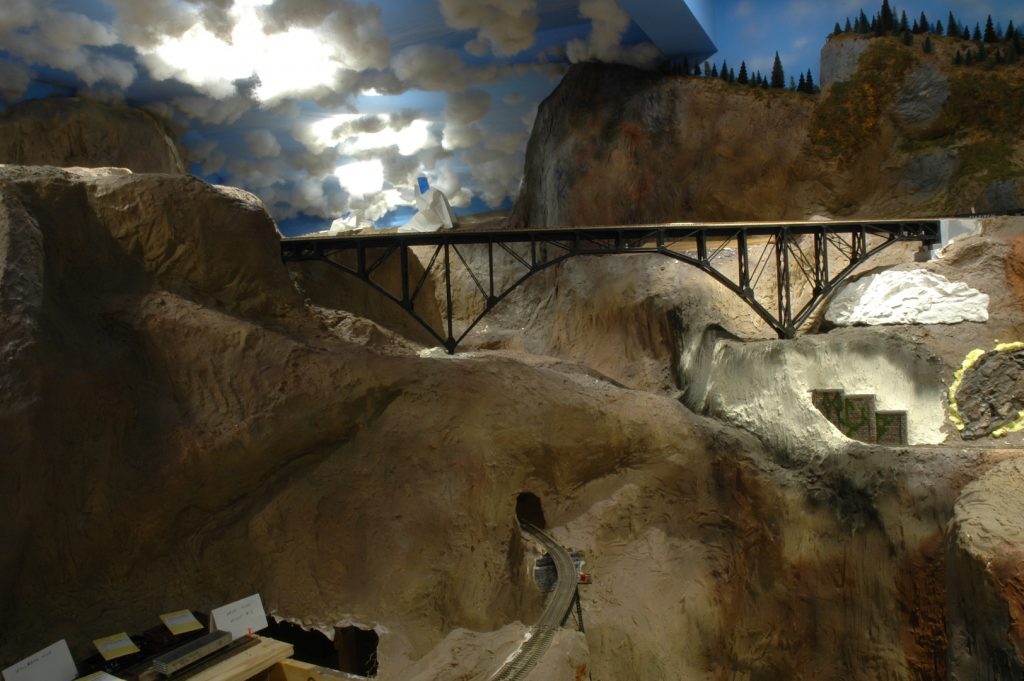
Photo 33 shows a closer view of the bridge. The bottom steel work does not support the bridge. There is a one-inch aluminum channel that runs the length of the bridge, it carries all of the weight. The channel is supported in both ends by solid wood abutments attached to the benchwork.
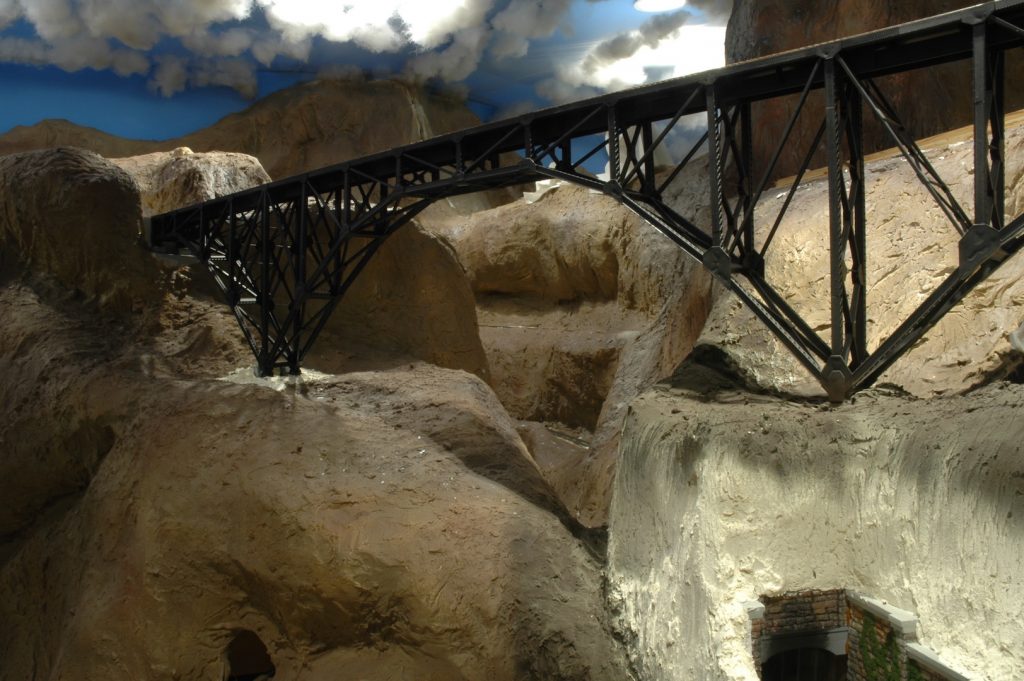
Photo 34 shows the central mountain. The mainline curves around to a second large bridge. Just like John Allen’s Gorre & Daphetid layout I have a spiral at the base of this mountain.
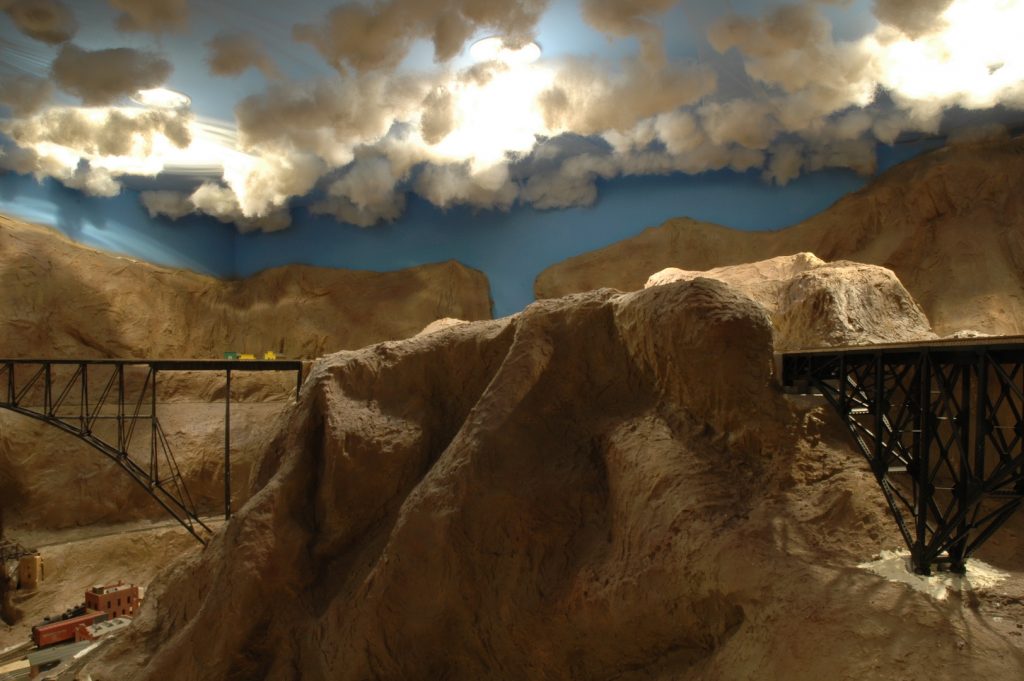
Photo 35 shows the second arch bridge. This is a close replica of the Vance Creek bridge located just out of Shelton WA. It is made from styrene with brass inserts for structural support. This bridge was constructed on a saddle shaped jig. Construction of this bridge was several months long. My model bridge towers over the town of Hayes River. To the extreme left you can see some of the snow-covered mountains and even more bridges. My freight trains are constantly gliding over bridges, blasting through tunnels or snow sheds, and battling tough grades with tight curves to move freight over the mainline through the mountains. Next time we will check out more of the bridges on the layout and give you a peek at the valley that is on the left.
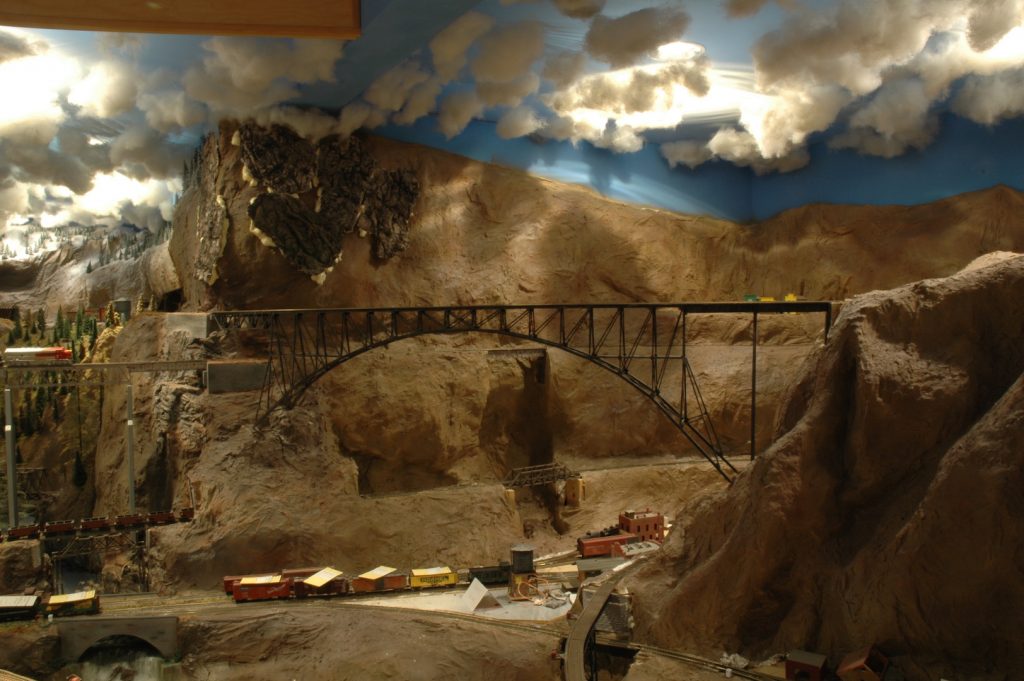
That is it for this week.
David
Bremerton Northern September 2020 Flimsy
Click here to read the September 2020 issue of The Flimsy Board from the Bremerton Northern Model Railroad club.
David Yadock’s Dry Gulch & Western Railroad – Part 6
By David Yadock
Dry Gulch & Western, A Photo Series Part 6
The Dry Gulch & Western has a varied list of motive power. I currently use quite a variety of different brands and wheel arrangements. There are Broadway Limited, Bachmann, Con-Cor, Proto 2000, modified Kato, Trix, and modified Athearn locomotives on the roster. The vast majority of the locomotives are sound equipped. I have begun (finally) lettering the locomotives for my railroad. Yes, this took a while, but it is slowly progressing. I have also begun the task of re-motoring some of my brass locomotives. I plan to add quite a few of them to the layout since I have been collecting them for years. They really should not be in cardboard boxes all of their life! Unlike John Allen, I have several diesels on the layout. Several Kato NW2’s usually “play” in the yards at Ellison and Newport. They are painted in the early SP tiger stripe configuration. I have two cow and calf sets for that purpose. There is a rather large fleet of Santa Fe F7 diesels on the layout. I originally started with a vintage Athearn F7 A and B powered set that I did a sound decoder installation. Since then I have added some Proto 2000 F7s also in the Santa Fe Warbonnet paint scheme. Did I also mention I have a couple of BLI Pennsy Sharknose diesels that run freights on the layout? Yes, I am a Pennsy fan, so those locomotives are allowed to run on my layout. So, let’s get back to the layout photos.
In photo 26 you are still looking back at Ellison, Taylor Junction, and all points beyond. This gives you a good view of both large control panels. These panels house most of the turnout controls for layout. Since they are only a couple of feet apart from each other it makes one-person operation of the layout’s mainline fairly easy. Continuous running of trains can be accomplished by changing direction of just two turnouts.
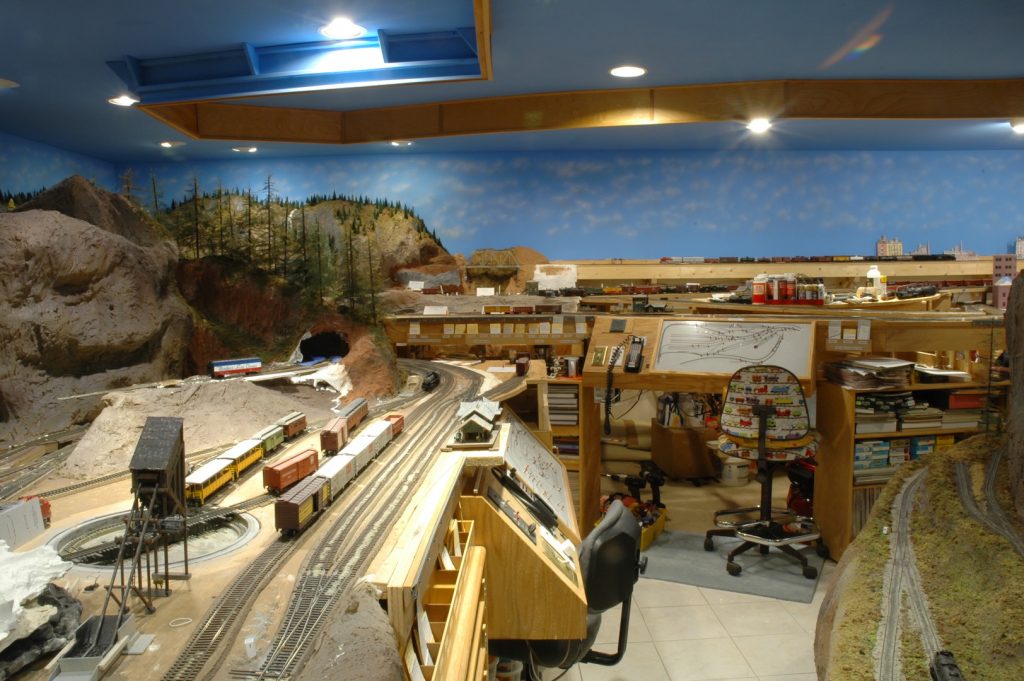
Photo 27 is a view of the very first bridge I built for the Dry Gulch & Western. It is located directly behind the tall gray mountain spire in photos 22 and 23 of part 4 of this series. It is a tall curved wooden trestle that carries the mainline. If it looks familiar this is my attempt to create the Ryan Gulch scene from the famous Gorre & Daphetid. This photo also shows the aisle in the floor to ceiling area of the layout. The blue colored carpeting mimics the color of a river.
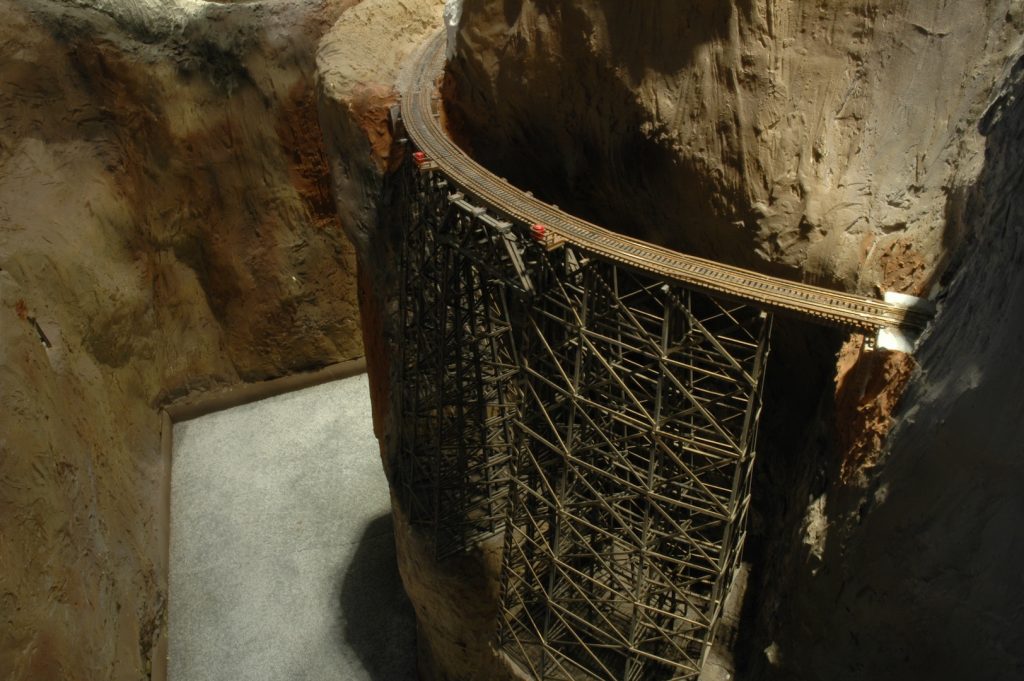
Photo 28 shows the view looking down the canyon. At the center top of the photo is the town of Alpine. Just around the bend from the wooden trestle is the hamlet of Raade Springs. Further around from the wooden trestle is the town of Potter Flats.
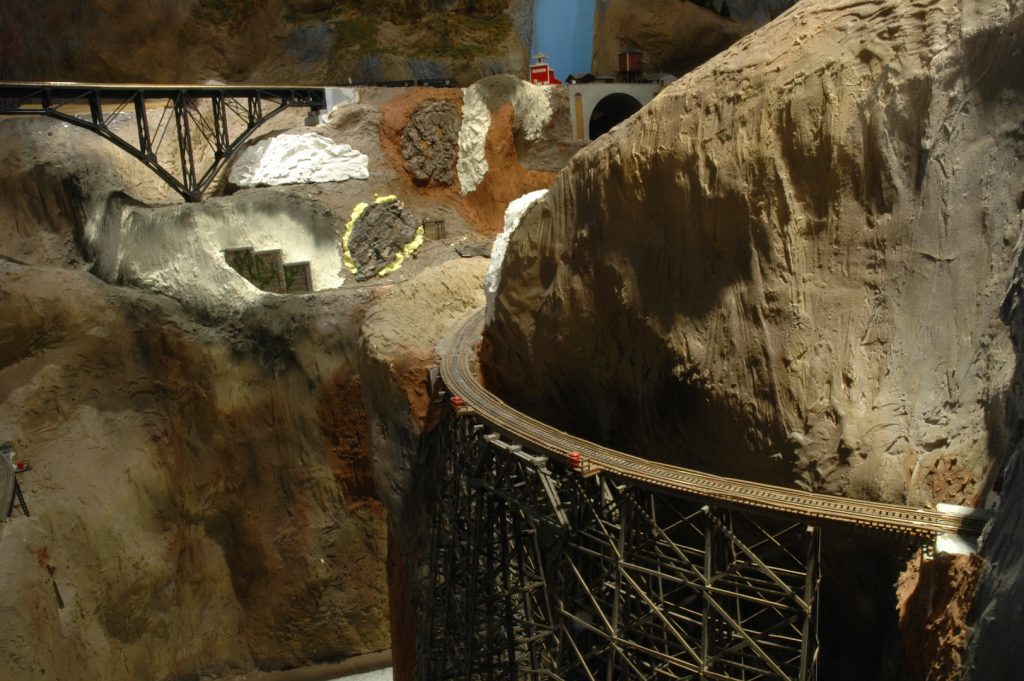
Photo 29 gives you the first view of Potter Flats. There is a mine and an oil drilling operation at that location. The little building above the rock outcropping in the foreground is Raade Springs station. (Please note that there is a lot of the scenery in this area that isn’t quite finished yet. That has significantly changed since Covid-19 and those pesky “stay at home” orders. At the end of this photo series I will try to post updated photos of this area.) On the left of this photo is my version of French Gulch, another borrowed or should I say “liberated” scene from the Gorre & Daphetid. Can you spot the large access hatch in this photo? It is almost in the dead center of the photograph.
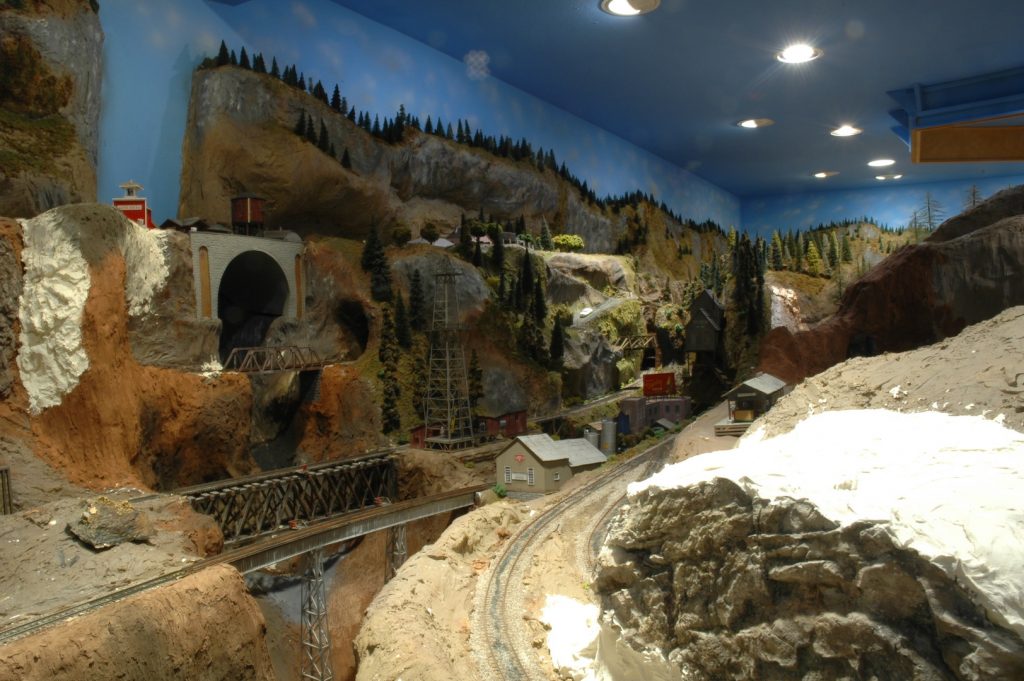
Photo 30 gives you a really good view of how things fit on the layout. It also shows the advantage of correctly placed view blocks. Let’s go across this photo from left to right. On the extreme upper left is the town of Alpine. As you go down into the valley you encounter Potter Flats. The rail line running straight up the photo travels to Gornitzka Crossing and beyond. The switch that sends the rail line off into the tunnel in the foreground is a sort of “backdoor entrance” to the town of Dry Gulch. Notice how the view blocks hide Gornitzka Crossing! In this photo to the right is Raade Springs with its small station. Even further to the right is Dry Gulch.
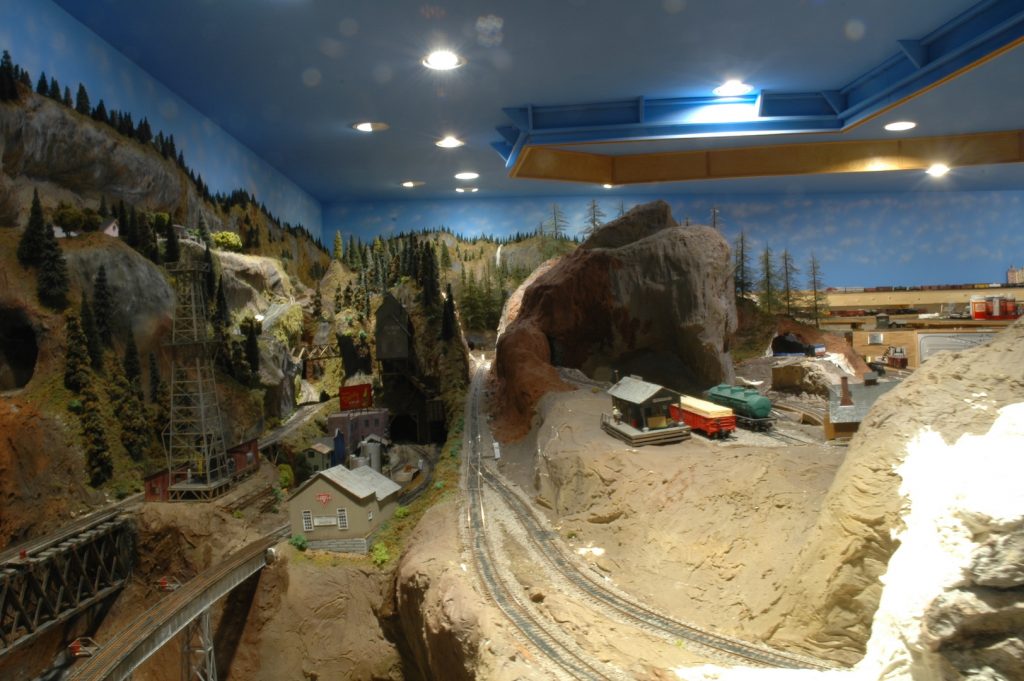
That is it for this week. Next time we will look at some more scenery under construction along with some of the bridges that hop from mountain to mountain. Did you folks ever find that access hatch in photo 29? Keep looking!
David
David Yadock’s Dry Gulch & Western Railroad – Part 5
By David Yadock
Dry Gulch & Western, A Photo Series Part 5
I’ll explain a little more information about my layout. As mentioned in the last installment I used a lot of plaster for the mountains. I also used a lot of paint. The mountains were painted almost all at once over a two-day period using cheap “rattle can” spray paint (about 40 cans). I draped plastic over most areas of the layout that would not receive paint. Track was taped over to protect the rails. I made a plastic tunnel that vented out to the garage. Air was driven out of the train room by two large fans and the garage was kept open till there was no longer any paint smell. Yes, I have a very good chemical respirator mask! This method of painting was effective to quickly eliminate the great white plaster mountain range. Doing this also allowed me the ability to look at shading and the actual shapes of the mountains. When they were white everything just blended in, once painted the mountains gained some contour that was hidden. I used 4-6 different colors of paint. This quick paint was just the start of scenery and was my initiation into learning how to “do” scenery. Yes, I am still learning how to do scenery and I find it fun to use new techniques. Now let’s see more of the layout.
Photo 21 shows a view of Dry Gulch. The station is above the control panel, another Campbell kit. At Dry Gulch there will be a scratch-built two stall engine house. A small Diamond Scale Models turntable is already in place. Dry Gulch is the interchange area for the narrow gauge and standard gauge. It is also the beginning of the layouts mining district. There will be several mines located on the layout. One mine, just barely visible in the photo is on the gray mountainside to the left. The town of Alpine is to the right of the stone arch bridge that is against the wall. Close to the stone arch is one of my other large bridges.
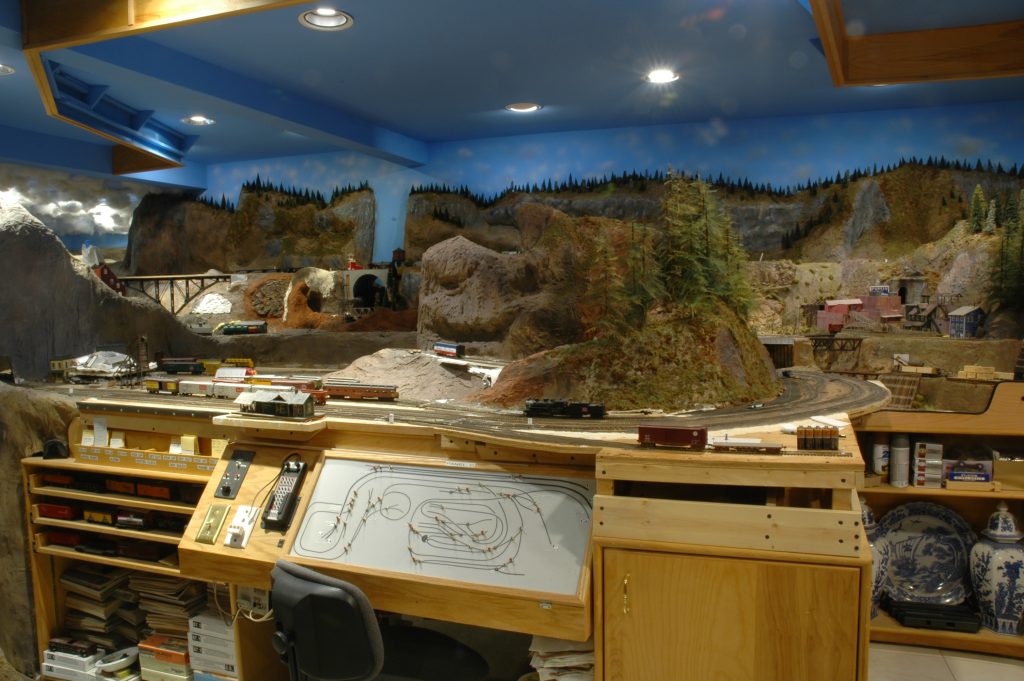
Photo 22 shows more of the bridge in the previous picture. That bridge is over 5 actual feet long. It is based on the Santa Fe’s Canyon Diablo Bridge. Can you spot the mirror in the photo? It should be easy since it is 2 feet by 6 feet in size.
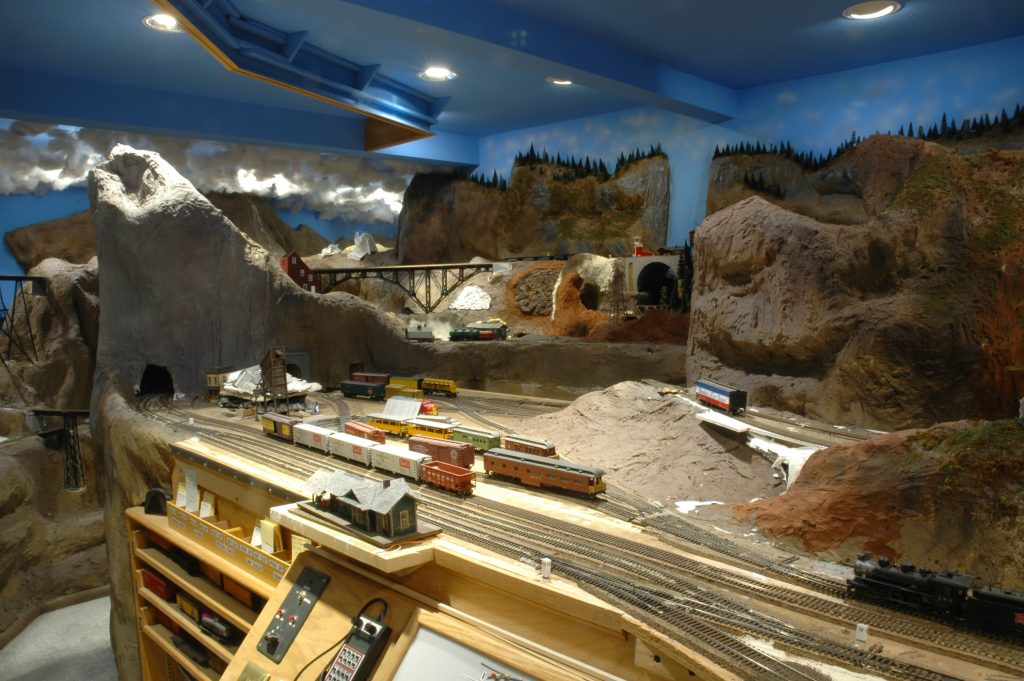
Photo 23 gives a view of my other large arch bridge. That one is based on the Vance Creek Bridge located in Shelton WA. This photo also shows how my aisle becomes a deep canyon. In this area scenery stretches from the floor to the ceiling. I admit this area of the layout is my favorite, walking down this aisle you literally become part of the layout. This photo also shows how much the trains need to climb in elevation. Hayes River is the town at the center left of the photo, it is at 29 inches above the floor. The track on the arch bridge that leaps over that town is at 61 inches above the floor.
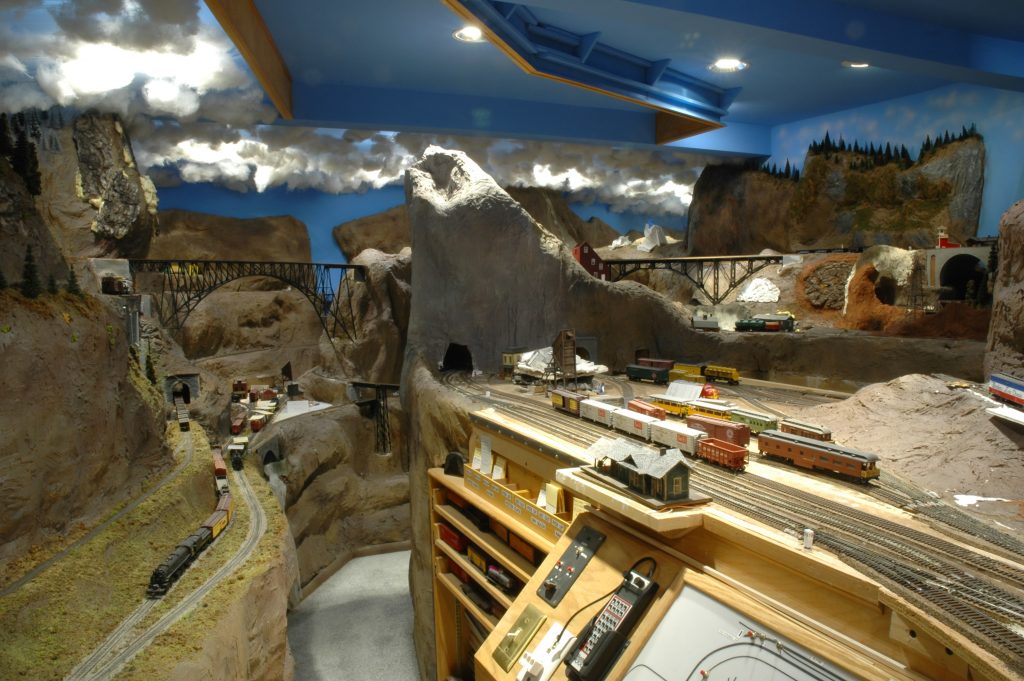
Photo 24 shows a view if you started walking down the aisle and looked back at Ellison. This photo gives you an idea of how my view blocks work and why they are needed. In the distance, against the wall, you can see a waterfall cascading down the mountainside. Yes, groups of those tall timber trees really make a nice view block. The tunnel that is by the Borden’s reefer is part of the branch line from Dry Gulch. That branch line services the small hamlet of Raade Springs.
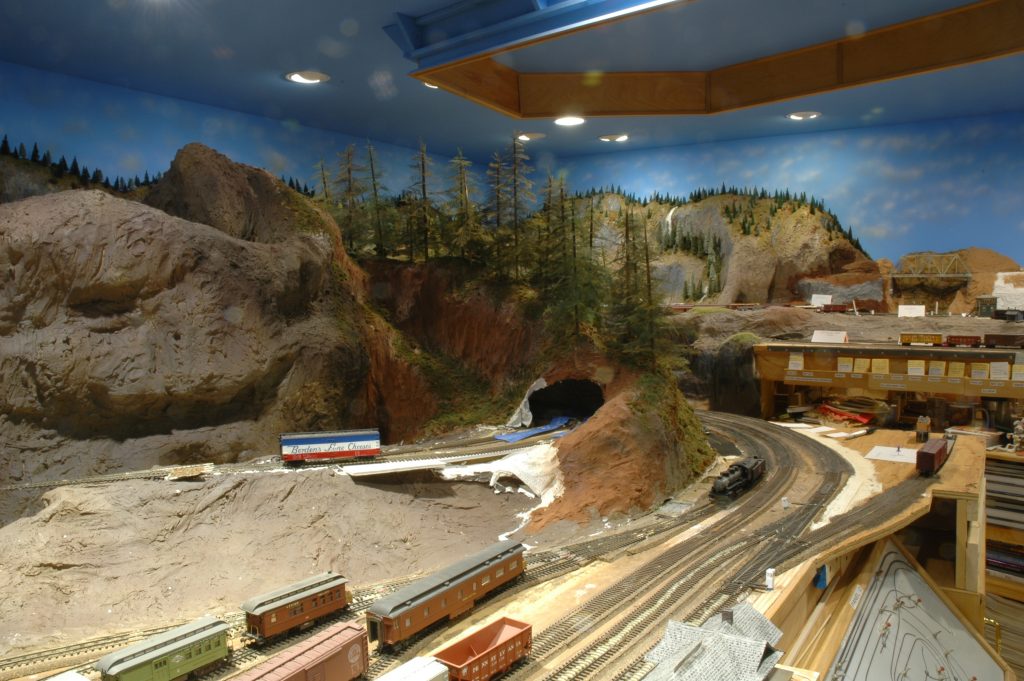
Photo 25 shows the turntable and the small interchange yard at Dry Gulch. This area still needs a lot of work, but it will eventually get done. At the extreme upper left of this photo is town of Alpine. Raade Springs is just out of the picture on the left. There is another mine perched by the small stand of conifer trees at the middle left. The open area in the photo will be an access hatch. It will be a vertical lift type. The town buildings of Dry Gulch will cover the hatch, hopefully making it invisible to the layout visitor.
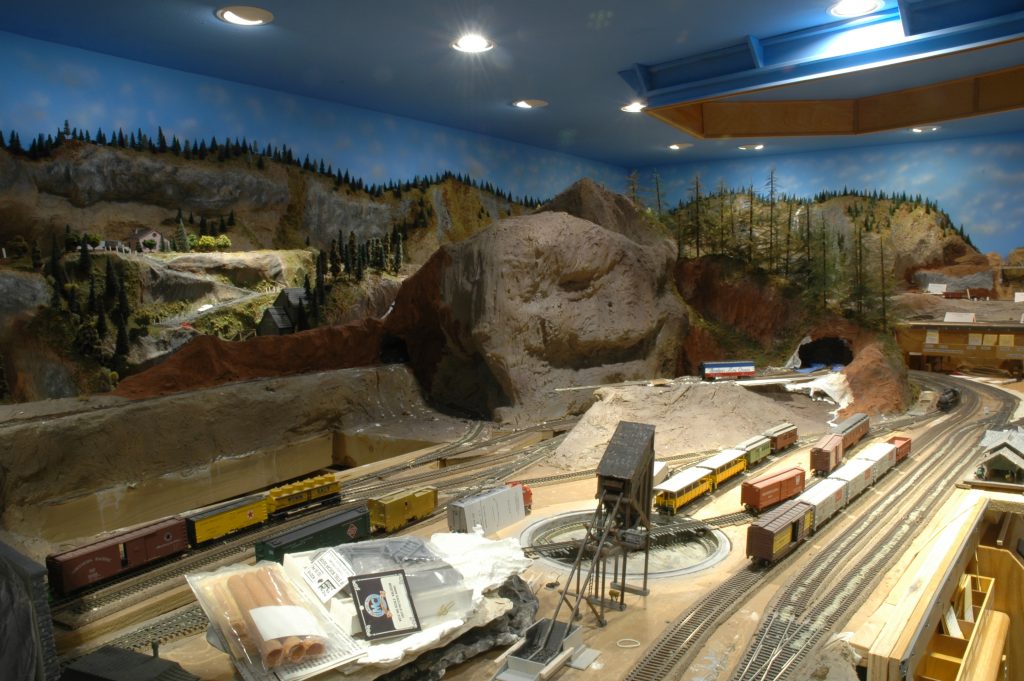
That is all for this week, next week we will see even more bridges and perhaps the town of Potter Flats. Actually, Potter Flats has been in most of this week’s photos, but carefully placed view blocks have prevented the town from being seen!
David
